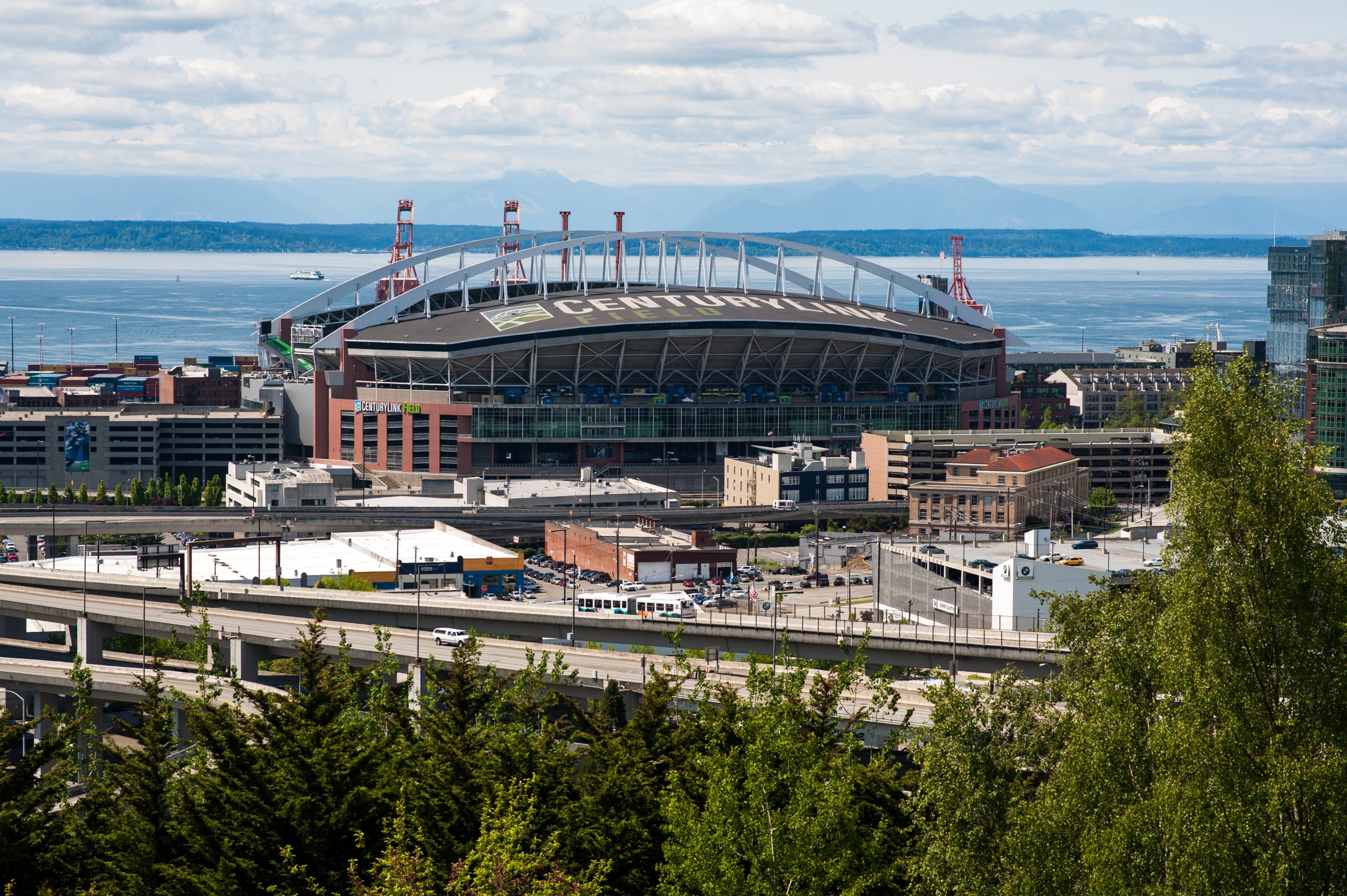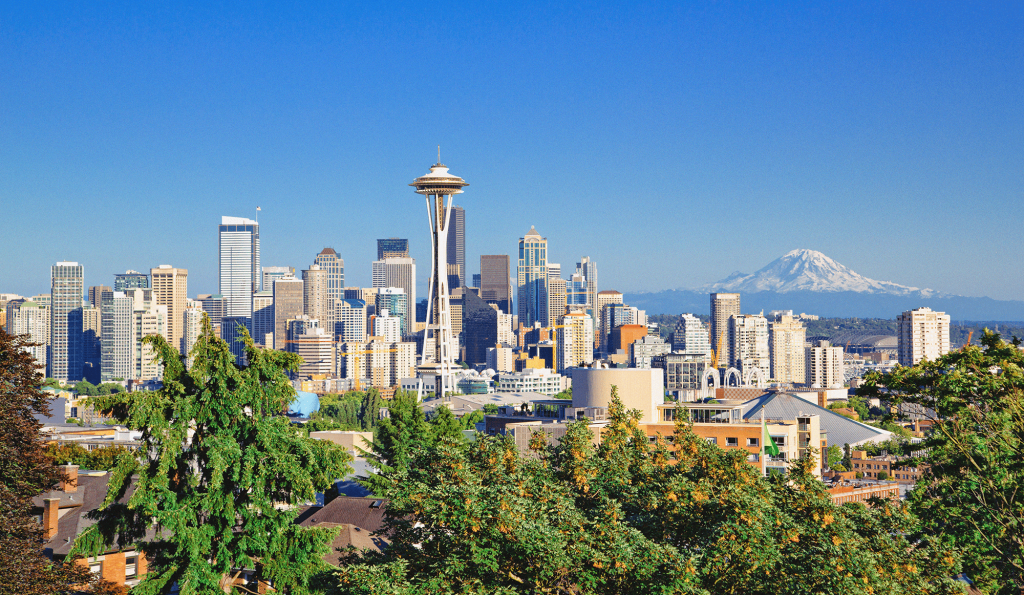
We found out everything you wanted to know about the makes The Emerald City so great to live in from the people that call it home. Download our Seattle Research Report to review all of the details.
Seattle: Fast Facts
Seattle is the 18th most-populous city in the US and the largest city by both area and population in Washington State, followed by Spokane and Tacoma. Located on a land neck between Elliott Bay (Puget Sound) and Lake Washington, Seattle is about four hours west of Spokane; about 37 minutes from Tacoma; about two-and-a-half hours driving from Vancouver; about 10 minutes from Bellevue; and about 23 minutes from Kent.
Seattle is currently growing at a rate of 1.5% annually and its population has increased by 28% since the most recent Census, which recorded a population of 608,660 in 2010. The Seattle metropolitan area has more than 3.5 million inhabitants, making it the 15th largest metro area in the country. Nearly 57 people move to the Seattle area every day, according to a study done in 2020.
Most residents from Seattle are known as Seattleites and the city is also known as Emerald City because the city and surrounding areas are filled with greenery all year round, even in the winter due to all the evergreen trees in the area.
Seattle has become modestly more racially diverse, with people of color comprising 37% of population in 2018, up from 34% in 2010. And the most diverse part of Seattle — the fast-gentrifying South End — actually became whiter.
I moved from Ireland over 10 years ago. The characterization of Seattle as a “big small town” or a collection of distinct neighborhoods is true. Dublin feels like more of a centralized big city. I like both in their own way.
Angie McC
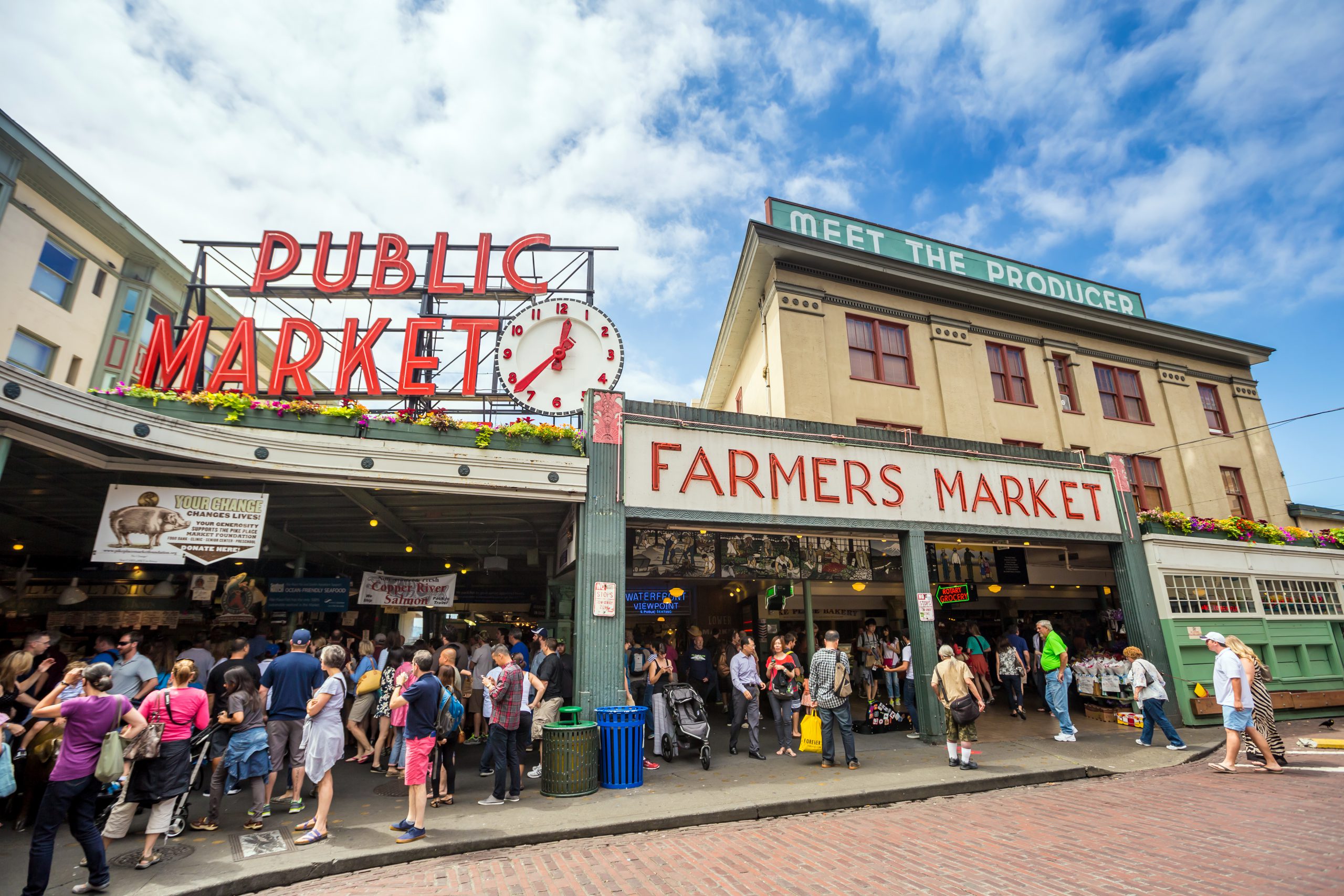
Seattle Neighborhoods
Fremont, located just north of downtown in the center of the city, has a bohemian vibe with indie shops, hip bars and quirky outdoor sculptures, including the famous gigantic Fremont Troll lurking under the Aurora Bridge and the towering Fremont Rocket. Arty residents and tech workers often hang out in the area’s eclectic eateries. The Fremont Sunday Market has art, antiques, and food trucks. Cyclists and walkers can explore the canalside Burke-Gilman Trail. Companies like Adobe Systems, Google and Getty Images are also based in this neighborhood.
Between Puget Sound, Pike Place Market and South Lake Union lies Belltown, Seattle’s unofficial entertainment and nightlife capital. High-rise condos, trendy restaurants, and entertainment venues like legendary The Crocodile (ever heard of a band that played there called Nirvana?), and other bars and places are all densely packed, making this neighborhood extremely walkable. In addition, Belltown’s proximity to other areas of town means the neighborhood has excellent public transit.
More than just the high rises that dot it, Downtown Seattle has a rich history and plenty of diverse culture. It’s the central business district of the city and is fairly compact compared to other downtown areas on the West Coast. It is the heart of what most people think of when they think of Seattle. Visit the Seattle Art Museum, The Showbox for music or a show, or hear a symphony at Benaroya Hall. Residents of this area don’t need cars — with bike lanes and public transit options galore, a vehicle can be more of a hindrance than a help.
Located just a few minutes north of Downtown, Ballard has roots as a Scandinavian seafaring village, and salmon still run through the Ballard Locks to this day. Today, the waterfront Seattle neighborhood is a hip destination and home for Seattleites who enjoy the variety of trendy restaurants, and quieter parts and streets up north. Bonus? Residents can walk on a sandy beach while enjoying stunning mountain views. Rents average around $2,000 a month — one of the more expensive areas of Seattle.
Art galleries, coffee shops, and trendy bars fill Pioneer Square’s late-1800s Romanesque Revival buildings. Seattle’s first unofficial neighborhood, tourists explore subterranean streets in Pioneer Square on the guided Underground Tour and learn about the city’s roots at The Klondike Gold Rush National Historical Park. Office workers unwind in secluded Waterfall Garden Park or grab lunch from food trucks at Occidental Square, a plaza with bistro tables and bocce courts.
Affluent Magnolia is a residential neighborhood on a peninsula jutting into Puget Sound. Families explore the beaches and forested trails of vast Discovery Park, home to West Point Lighthouse and indigenous art at the Daybreak Star Indian Cultural Center. Smaller Magnolia Park has expansive water views. Locals mingle in the Village, a cluster of upscale shops and cafes, and site of a summer farmers’ market.
Laurelhurst is ranked at the top neighborhood in all of Seattle. It has some of the best educational opportunities with amazing amenities and a higher median income than much of the city. The University of Washington is just a short walk away, and it is northeast of downtown, which is a short ride from Laurelhurst. It’s near Wolf Bay and has beautiful views of the ocean, with Laurelhurst Park at the very center of the neighborhood. With plenty of dining and eponymous Seattle coffeehouses, living in Laurelhurst is a great Northwest experience. However, for residents on a budget or looking to save money, this neighborhood probably isn’t for them.
Located directly north of Lake Union, Wallingford is a centrally located Seattle neighborhood that still feels suburban. Wallingford is also one of the safest neighborhoods in Seattle, making it a popular place for families. On either side of Wallingford are Fremont and the University District, giving residents access to more bustling, hip areas. In Wallingford, there are sidewalk cafes, interesting shops, and refurbished buildings. Enjoy access to two different parks, and the famous Dick’s Drive-In.
Wedgwood is a mellow place with modest, well-kept homes and an active community. It has a couple streets with a standard assortment of restaurants, coffee shops, bars, and basic services like a dry cleaner. This is a great place for families given its many schools, including one of its leading preparatory schools. Wedgwood is bordered on the north by Lake City, on the east by View Ridge, on the south by Bryant and Ravenna, and on the west by Maple Leaf.
Northeast of Downtown is Capitol Hill — one of the city’s most densely populated areas, featuring a mix of old and new homes and condos. Considered to be Seattle’s LGBTQ+ capitol, the neighborhood is diverse and accepting. With lots of gay bars, nightclubs, indie coffee shops and more, Capitol Hill is also a highlight for food lovers, with some of the best restaurants in the city. Capitol Hill residents find respite at Volunteer Park or the Seattle Asian Art Museum.
I’m in the very center of Capitol Hill, Modera Broadway. It offers you an apartment home set in an artsy, exciting, hotspot like no other. And just like the neighborhood outside, it offers you endless options for fun.’
Tonya L
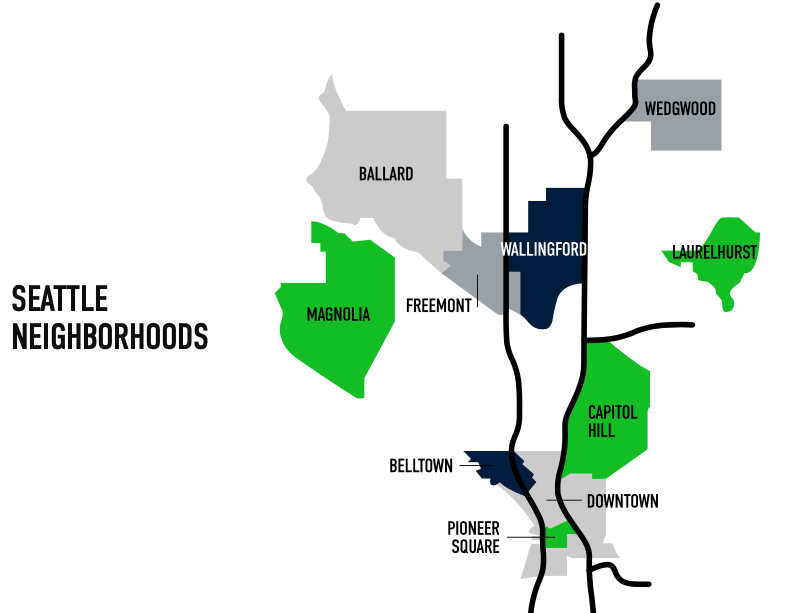
Doing Business in Seattle
Seattle offers major attractions, it’s also known for it’s unique music scene, museums, and a modern, international airport.
Key Industries: Aerospace, Agriculture, Clean Technology, Forestry Products, ICT, Life Sciences, Maritime and Military
Major Employers: Amazon.com, Starbucks, Costco, The Boeing Co., Microsoft Corp., Joint Base Lewis-McChord, University of Washington Seattle, Providence Health, Walmart, Nordstrom, Barrett Business Services, T-Mobile
Major Tech Companies with Offices in Seattle: Amazon, Facebook, Google, Tableau, Microsoft, Expedia, Apple, F5 Networks, Zillow
Major Financial Services and Insurance Companies with Offices in Seatthle: Gravity Payments, Moss Adams, Russell Investments, Seattle Credit Union, Washington Federal Savings, PATH, PEMCO, Safeco, Trupanion
Seattle startups brought in $3.2 billion in venture capital through the first three quarters of 2020, according to Pitchbook, putting the city on track to easily break its previous high of $3.6 billion in 2019. Many were in fields like health care, A.I., enterprise software, and gaming–industries that are showing no signs of slowing down in 2021.
After its 1994 launch, Amazon got out of the garage quickly, moving across the lake to fill 630,000 square feet of office space in Seattle by 2001. Since then, the company has rapidly expanded downtown, growing to occupy 19% of all prime Seattle office space, according to a 2017 analysis by the Seattle Times. Amazon’s growth has meant that Seattle has seen a huge shift in its local economy. Wages have increased by almost $21,000 on average while the unemployment rate has dropped by almost 6%. With over 100,000 new residents in Seattle, the housing supply has struggled to keep up despite an explosion of new construction. Given the high demand, housing prices have soared.
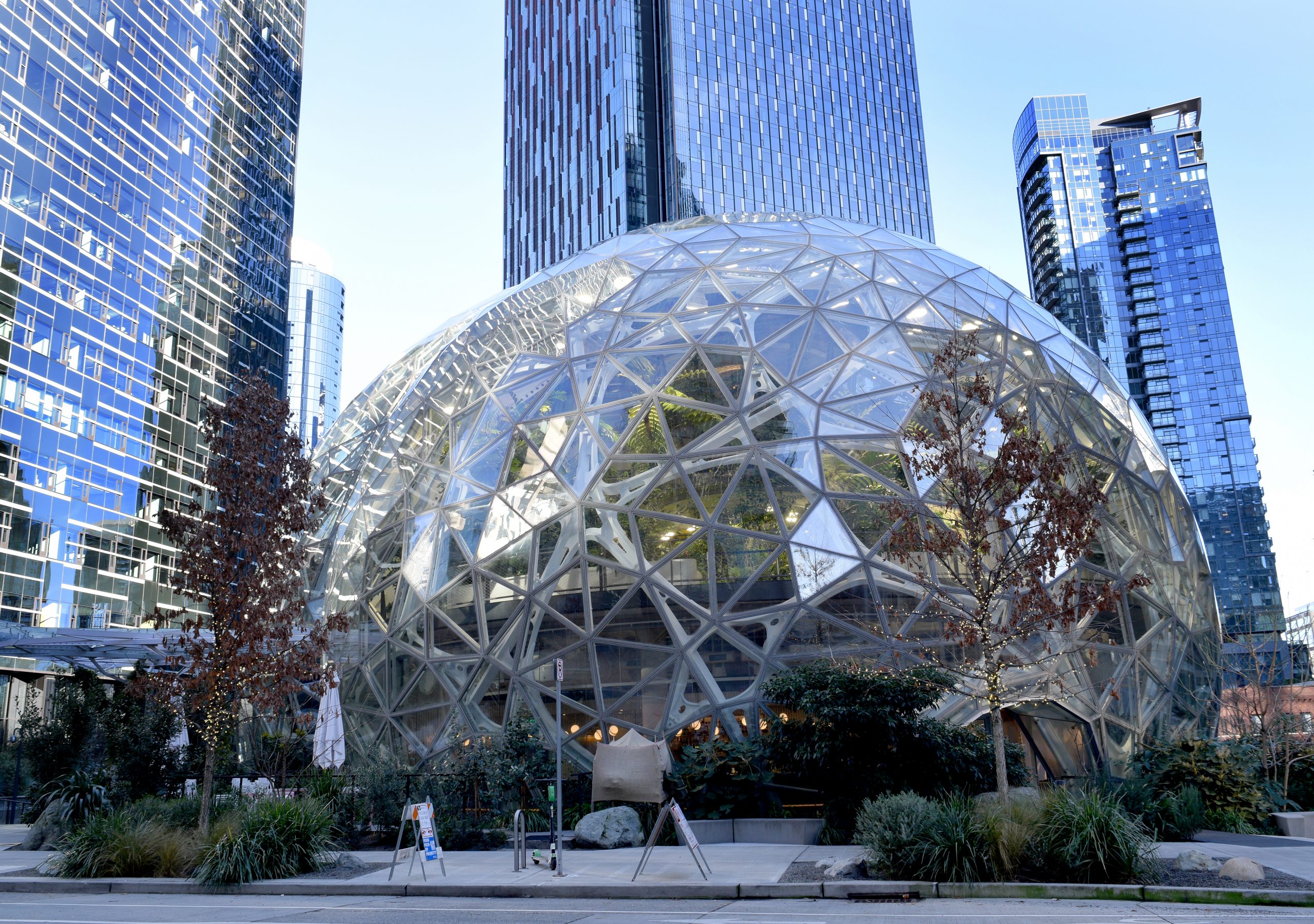
Cost of Living in Seattle
A study looking at the cost of living in 257 cities across the United States has ranked Seattle as the fifth most expensive place to live in the country. The quarterly study looks at six categories — housing, utilities, grocery items, transportation, health care, and miscellaneous goods and services — to determine rankings. It measures regional differences in the cost of consumer goods and services, excluding taxes and non-consumer expenditures, for professional and managerial households in the top income quintile.
For prospective homeowners, the median home in Seattle is about $14,000 above the national median, coming in just over $245,000. This, paired with the average costs of living and easy access to all of the amenities and entertainment venues, makes Seattle an appealing city to call home.
Seattle Apartment Living
Living in Seattle is almost twice as expensive as the United States’ average. The largest expense is housing, whether renting or purchasing a home. Transportation is also a significant cost for Seattleites, but the exorbitant costs end there. However, in many other categories, such as groceries and healthcare, Seattle residents pay a similar amount to many other Americans.
The Seattle City Council approves new tax on big businesses in 2020. Under the new tax, companies with annual payrolls over $7 million will be taxed based on their pay to employees making over $150,000 per year. The tax rate would range from 0.7% to 2.4%, with tiers for various payroll and salary amounts. Money from the tax will be used to underwrite $86 million in coronavirus relief to shore up city services as Seattle emerges from the pandemic and over the long term to pay for affordable housing, business assistance and community development.
According to ApartmentGuide, these Seattle neighborhoods offer a good selection of rental apartments, unique dining, shopping atmosphere, and a sense of community:
- Wallingford ($1,450/mo for a studio*)
- Queen Anne ($1,553/mo*)
- Capitol Hill ($1,581/mo*)
- Downtown Seattle ($1,707/mo*)
- Ballard ($1,873/mo*)
What Seattle Renters Want
No two renters are the same, but many Seattle renters are constantly seeking features and amenities. Here are the top things tenants report looking for in a property.
- In-Unit Washer/Dryer – Simply makes a unit more attractive to most renters. It means more privacy and more convenience, and if utilities are included on the property, it means less in monthly costs, too (at least for the renter)
- Dishwasher – The process is time-consuming and wastes gallons of water. Energy-efficient dishwashers use less water per cycle than used for washing for
- Online Rent Payments – We live in a digital age. Payments are becoming increasingly reliant on digital methods such as direct deposit, direct withdrawal, and simple money transfers. Paying rent online is not only convenient, but it’s also more secure. More importantly, it reduces the chances that renters will forget to pay on time.
- Fitness Centers – If residents work out at a gym, having a fitness center in the complex is a great benefit. A fully-stocked gym with a wide variety of equipment can allow residents to cancel their regular gym memberships. Better yet, they’ll save time and gas on trips to the gym.
- Property-wide high-speed Wi-Fi amenities – These days, high-speed Wi-Fi is a must. Make sure to give your residents a great connection throughout your common areas. They may need to download music in the gym, stream a movie in the lounge, or hop on a conference call in coworking spaces. This is one high-end apartment amenity that is definitely worth the investment!
- Modern or Smart Features – With all the technology available today, it’s no surprise that most tenants are looking for properties that are tech-savvy. In a world where renters are becoming more tech-savvy, apartments have to be up-to-date with the latest features. This could extend from simple features like USB charging outlets to more complex amenities like internet-connected HVAC systems and locks. Also, with the growing need to be constantly online, renters are now looking for places that feature a strong cell reception and wireless/wired connectivity for all their smart devices. Today’s tenants want the convenience of having an online payment and maintenance request option.
I feel comfortable with my monthly rent. Yes, Seattle tends to be more expensive than other big cities, but we have a lot to do.
Gio V.
Arts, Recreation, and Entertainment in Seattle
Seattle has the reputation as one of the greatest arts cities in the world—after all, this is the home of music legends like Nirvana, Jimi Hendrix, and Pearl Jam. Dancers, artists, musicians, and writers showcase their craft in new and unexpected ways. Seattle Symphony plays the classics and puts adventurous twists on famous soundtracks. Museums, galleries, and public parks shine the spotlight on treasured artifacts as well as the best in contemporary art. Pacific Northwest Ballet embraces boundary-pushing choreographers for new dance expressions en pointe. And the city is home to more than 80 theater companies, presenting new work and classic favorites in captivating productions on stage.
Seattle’s Chihuly Garden and Glass showcases the oeuvre of glass from world-famous glass artist Dale Chihuly. This forward-thinking museum inspires creativity and imagination as much as it pays tribute to the artist, through a surreal landscape of colorful glass sculptures that interact with the natural environment. The project features three primary components: the Garden, the Glasshouse, and the Interior Exhibits, with significant secondary spaces including a 90-seat café with additional outdoor dining, a 50-seat multi-use theater and lecture space, retail and lobby spaces, and extensive public site enhancements beyond the Garden.
The Get Moving Initiative Community Program allows Seattle Parks and Recreation to provide culturally relevant physical activities, events and programs in neighborhoods and for communities that have Health Disparity Indicators of 20% or higher in the categories of “no physical activity” and “rates of obesity”, as defined in the 2014 King County Public Health Survey.
Ask any Seattleite about their favorite sport and you’ll hear about everything from football to basketball to soccer to baseball. Seattle’s sports history continues today with the city’s eight major professional teams:
- Seattle Seahawks (NFL)
- Seattle Mariner (MLB)
- Seattle Sounders FC (MLS)
- Seattle Storm (WNBA)
- OL Reign (NWSL)
- Seattle Seawolves (MLR)
- Seattle Dragons (XFL)
- Seattle Kraken (NHL)
Read the full research report: Seattle, WA. We interviewed the people that live there to find out what makes their city special. Stay tuned for more city research.
